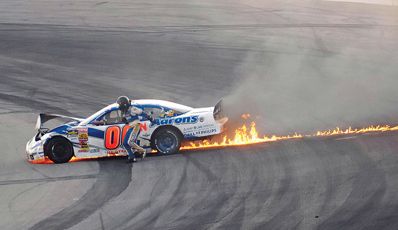
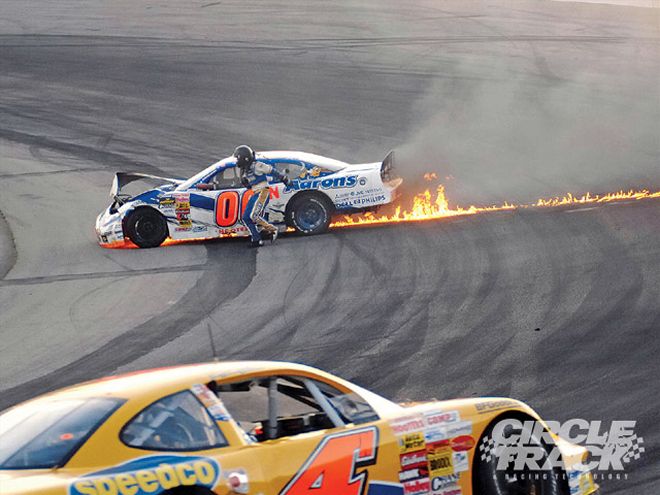 Fuel and Oil lines are easily overlooked, but I can assure you that overlooking these lines will sideline you at some point during the year.
Fuel and Oil lines are easily overlooked, but I can assure you that overlooking these lines will sideline you at some point during the year.
As a driver, there's nothing scarier to me than being in the cockpit, completely strapped up, when a fire breaks out. The thought of trying to get out while the car is engulfed would scare any driver. But nonetheless, this is why we run the three-layer suits and protective equipment.
However, there's a lot that can be done to avoid ending up in situations just like that, a lot of which has to do with your fuel and oil lines. If you're running a dry-sump system, then you'll have about a mile of oil lines strung throughout the car, along with the fuel lines that run from the back of the car to the front. If you're running a wet-sump system, a lot of these principles we're going to discuss will apply only to your fuel lines.
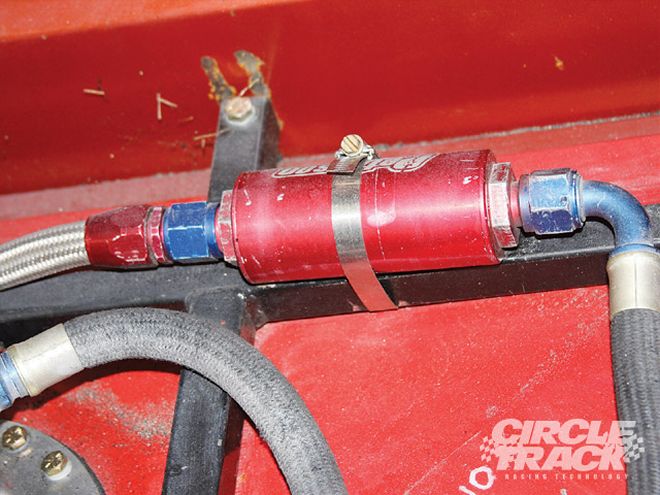 Inspect your lines week to week to ensure that all of your fittings are tight and not leaking. Pull the filter and clean it to make certain that your fuel has no blockage.
Inspect your lines week to week to ensure that all of your fittings are tight and not leaking. Pull the filter and clean it to make certain that your fuel has no blockage.
The teams that pay close attention to their oil and fuel lines are doing so to not only ensure everything is tight, but also to avoid disaster. If the fuel-line fitting breaks from the fuel pump, you'll have serious problems when that fuel starts to dump on the headers.
When you're running your fuel and oil lines, you need to make sure that you're attaching them to the chassis wherever you can. Remember, the car will travel a lot, especially in the front, but a lot of teams forget about the driveshaft traveling up and down into their dry-sump system. I was extremely lucky at a race last year at Iowa Speedway when my driveshaft traveled so far it started rubbing the inlet fitting for the oil container in the back of the car. It rubbed the fitting to where all that was holding it on was maybe one or two threads. Luckily, it made it through the race and we were able to replace it once we returned to the shop.
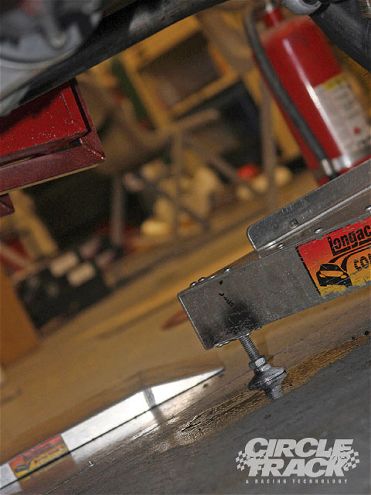 If you have a puddle like this one forming every week in your shop, then you need to determine where the leak is coming from and do something about it.
If you have a puddle like this one forming every week in your shop, then you need to determine where the leak is coming from and do something about it.
To this day, I don't know why anyone is running any other type of fuel line besides a steel-braided line. Steel-braided lines are so much more durable than typical rubber line. The rubber line can only bend so far before it crimps, but a steel-braided line will help prevent crimping much better. If the fuel line became crimped, you could be looking at an expensive engine bill because the motor was robbed of its fuel and you cooked a piston.
In addition to the crimping issue, steel-braided lines are much safer than rubber lines. Imagine backing your car into the wall at a high rate of speed. It will try to fold the chassis under itself and crush any fuel lines in its way. By installing the steel-braided lines, you can go a long way to prevent the fiery situation we talked about earlier.
I understand that steel-braided line is more expensive than rubber line, but we're talking about your fuel line in your high-horsepower race vehicle here. Eight dollars a foot isn't so far fetched (remember those $1,400 canister shocks?). And after all, it's transporting the most dangerous fluid in your race vehicle. Why make things more dangerous for you or your driver simply because you want to save a few bucks?
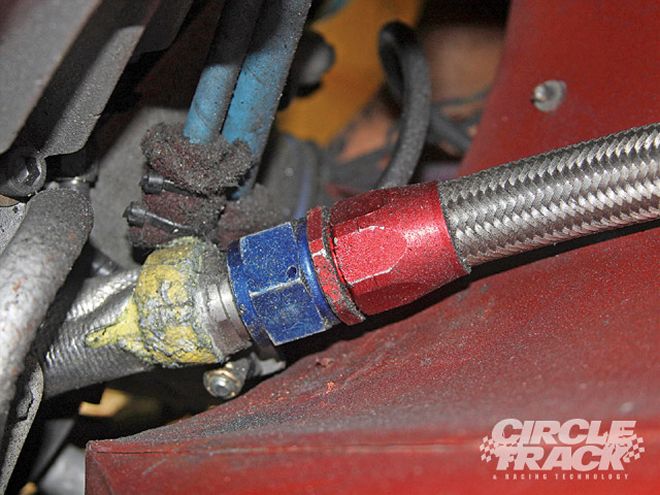 Ahhh, there's the culprit. Check first to see if the fitting is loose or if the entire fitting needs to be replaced.
Ahhh, there's the culprit. Check first to see if the fitting is loose or if the entire fitting needs to be replaced.
The photos in this article show how to properly install a fitting onto steel-braided line. But one area which is more important, and often overlooked, is marking the fitting. When you are installing the fitting, take a permanent marker and mark the line at the end of the fitting as shown in the photo on page 84. This will be a point of reference when you're doing your weekly check through your car. Just glance at your fittings and see if the line has started to pull through the fitting.
The fittings need to be inspected on a regular basis; one of the best investments you can make for your race team is purchasing a set of line wrenches. The line wrenches are made specifically for your fuel and oil lines and will help prevent you from rounding off any edges on the fittings.
The other thing you should pay close attention to is the sizing. Make sure that you are putting the right fitting on the right size line. There should be some resistance but not to the point where it's a strain for you to apply the fitting on to the line.
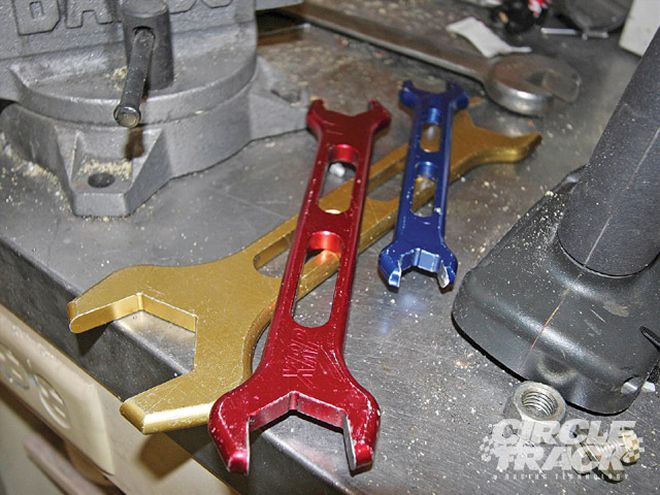 Investing in a set of line wrenches is one of the best tools you can have to make sure all of your fittings are tight.
Investing in a set of line wrenches is one of the best tools you can have to make sure all of your fittings are tight.
After each race, you should inspect your fuel and oil lines for any cuts or abrasions. One of the tale-tale signs of a problem is, obviously, puddles that start to form on your garage floor. Once you find where the leak was coming from, it's extremely important to determine how the cut or gash got there. Determine if it was an isolated occurrence such as running over debris, or something that has the potential to reoccur.
While you're checking the lines for cuts and abrasions, you should also do a weekly check of all your fittings. Remember to resist the temptation to tighten them more every time you check them. This will end up breaking the fitting. All you're doing is simply making sure that they are secure.
This off-season, I would suggest pulling all of the fuel and oil lines out of the car and inspecting and replacing the lines and fittings that are worn or leaking. By ignoring your fuel and oil lines, you run the risk of ending up on the sidelines. Don't let something so small and fixable park that good run you had going.
Now we'll discuss how to properly attach a fitting onto a stainless steel-braided line.